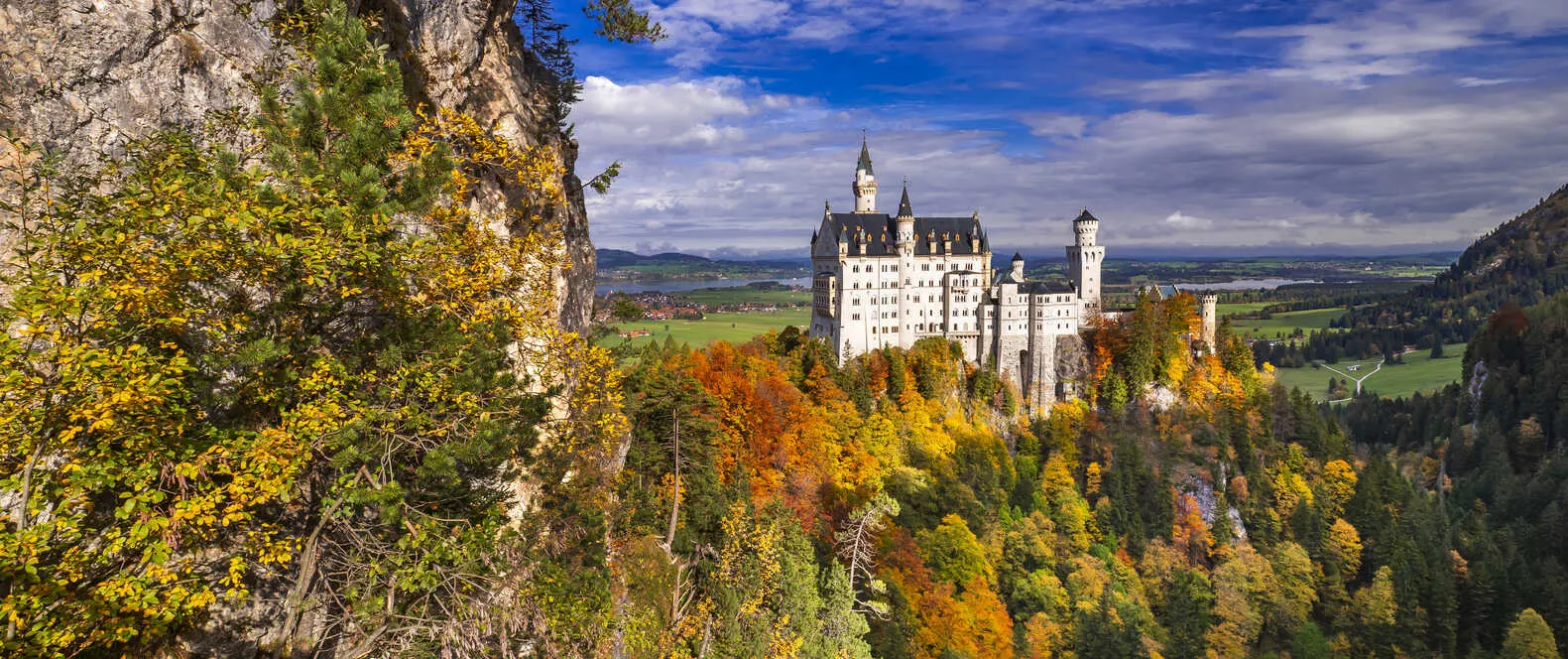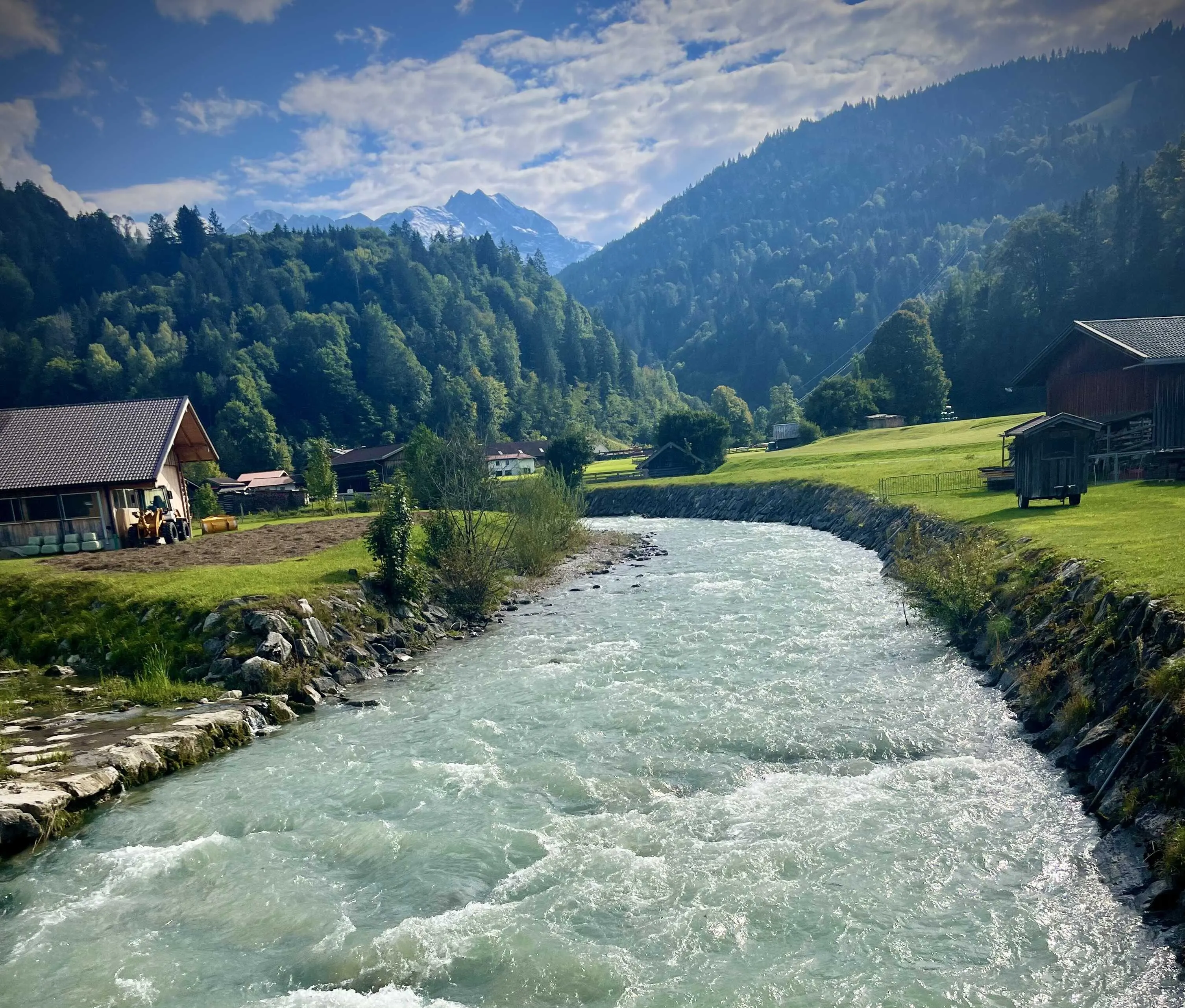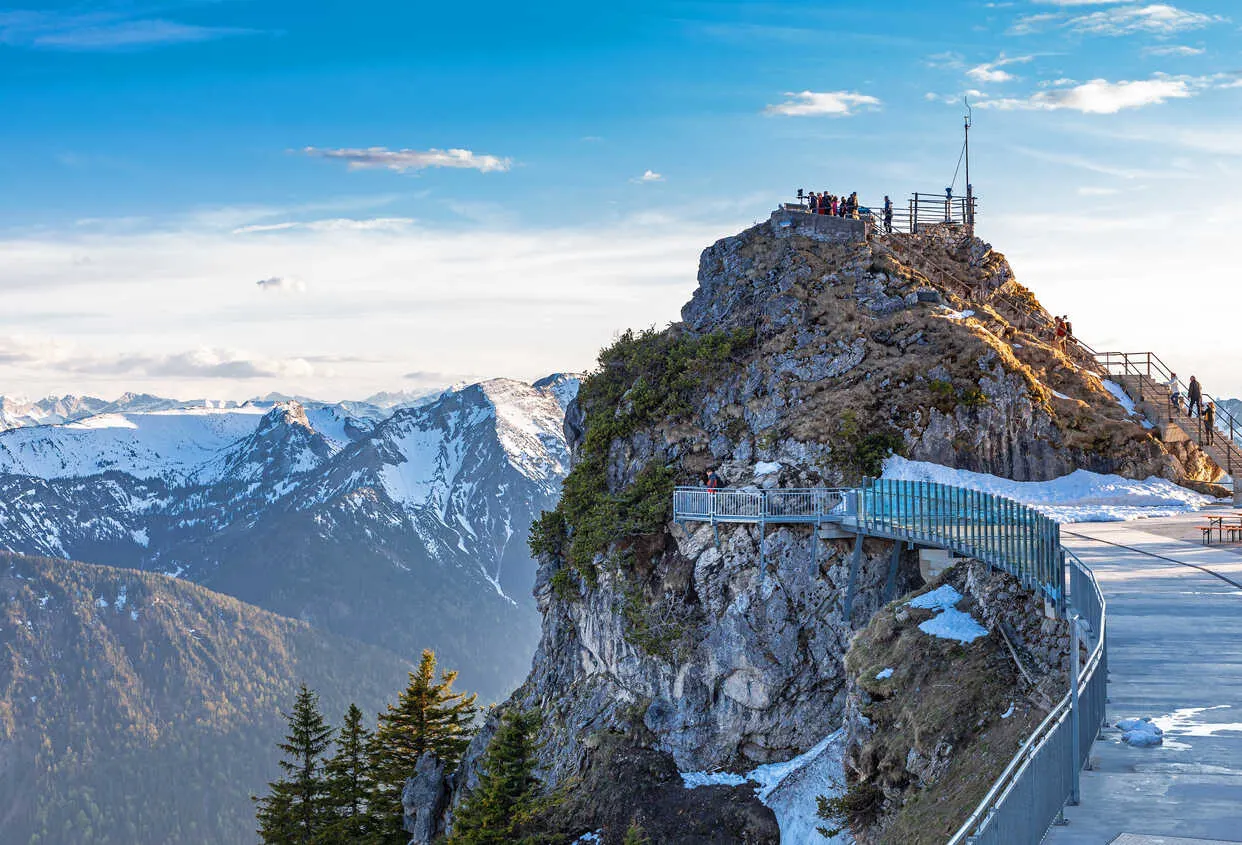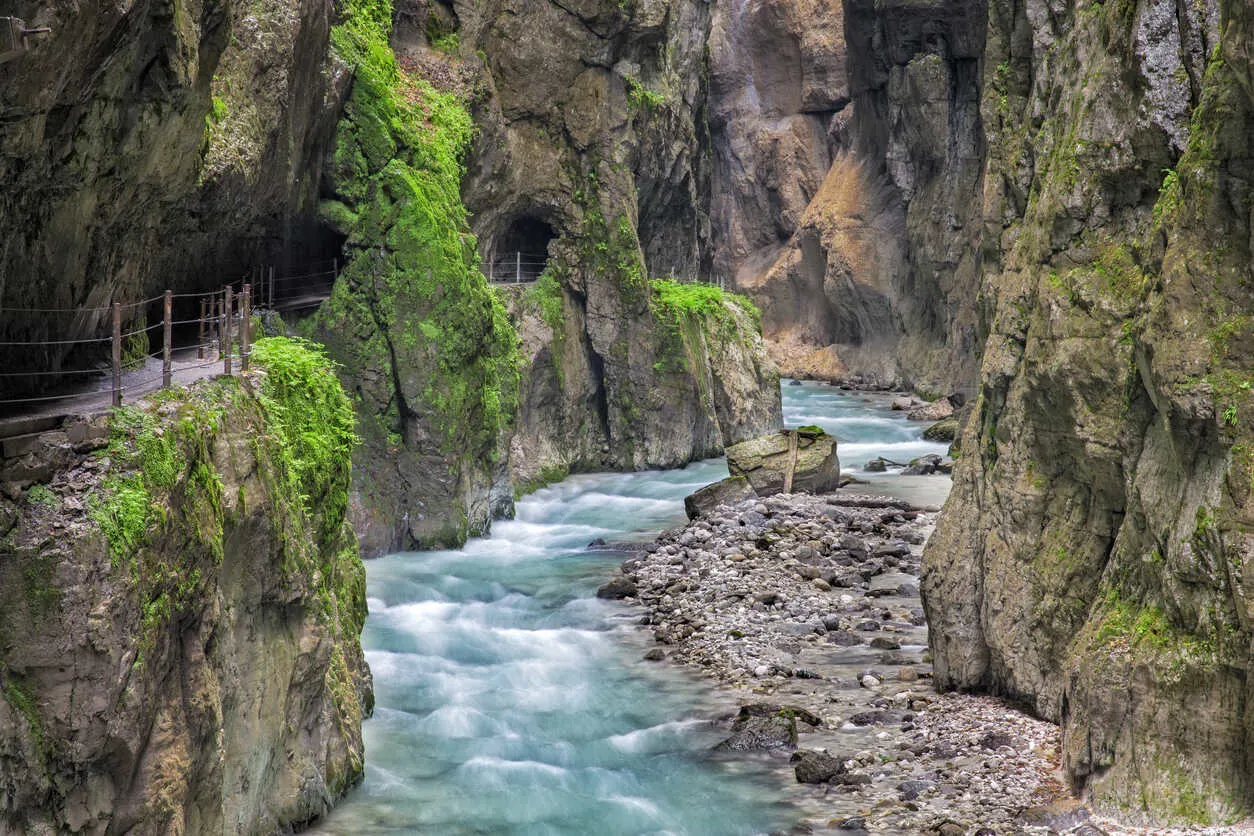Munich is a beautiful 12th-century city in Bavaria, 140 km from the German-Austrian border, with a much slower pace and more traditional feel than the eclectic and bustling capital city of Berlin. If you walk around the lush English Garden or the Old Town with its colorful painted façades and cobblestoned streets, you wouldn’t know that Munich’s been through quite a lot in its nearly 900 years—conquests, plagues, fires, bombings, and reconstructions. As a result, Munich’s architecture captures the eye with Neo-Gothic styles such as the Munich Rathaus New Town Hall and the Nymphenburg Palace; the Renaissance-style Residenz Palace; and even ultra-modern, futuristic designs like the spiral parabola slide at the Technical University of Munich (TUM).
On the cultural side, Munich offers arts and music, tradition, beer gardens, and of course, its famous Oktoberfest, which attracts 6 to 8 million visitors every year. And yet, as odd as it might sound, I couldn’t fully appreciate Munich without taking the train outside the city to really understand why Bavarians are so proud of their mountains and pristine nature. In fact, this is true for many people who move to Munich. The Alps will capture your heart whether you visit to unwind, digitally detox, destress, or push your limits on one of the thousands of hiking trails.
On a clear day, you can see the splendor of the nearby Bavarian Alps from the south-facing top floor of any building in Munich. Still, many people spend a pretty penny traveling to Switzerland for their “hills are alive” moment from the 1965 Sound of Music film, without realizing they can have that experience right here in Bavaria. It still amazes me that only one to two hours outside Munich, I can spin around with arms stretched in a lush mountain pasture with purple peaks in the background, pretending to be Julie Andrews—and still be home in my flat by 8 p.m.
These spectacular Alpine scenes reveal crystal-clear lakes, mountain cows wearing clanking bells, and quaint villages with Bavarian cottages and bright purple flowers on the windowsills. These spots are wonderful getaways for fresh air, great food, beer, scenery, hiking, and outdoor activities like biking, swimming, stand-up paddleboarding, or paddle boating.
For newcomers or visitors to Munich, there are five unmissable day trips that have truly stolen my heart, and all are easily reachable by public transportation: Füssen, Garmisch-Partenkirchen, Mittenwald, Eibsee, and Wendelstein.
The World’s Best Retirement Havens for 2026
The World’s Best Retirement Havens for 2026
24 Countries Compared, Contrasted, Ranked, and Rated. You don’t have to be rich to enjoy a pampered retirement, you just need to know where to go. With our 35th Annual Global Retirement Index, our experts hand you a detailed roadmap. Details—and a Special Offer—Here

By submitting your email address, you will receive a free subscription to IL Postcards, The Untourist Daily and special offers from International Living and our affiliates. You can unsubscribe at any time, and we encourage you to read more about our Privacy Policy.
Exploring Bavaria’s Day Trips by Train

These five destinations are in the Bavarian federal state (Bundesland), which includes Swabia, a cultural and historical region that also covers Baden-Württemberg, and the Allgäu Alpine region, which extends into Austria. This area is a breathtaking train ride away and always makes me feel so grateful to be here. It’s nearly impossible to return from the majestic Alps stressed or in a bad mood.
If you live in Germany, these day trips are easily reachable by regional trains using the Deutschland Ticket (currently €58/month), while tourists can purchase a Bayern Ticket (€32 plus €10 for each additional passenger). Purchase tickets at station machines or download the Deutsche Bahn website (or app), and don’t forget to check for updates the night before, especially on weekends, when timetables often change and detours or modifications are common (particularly on Sundays).
I recommend non-stop trains when possible, especially since Deutsche Bahn is famously known for its delays (DB sadly shatters many people’s ideas of “German efficiency”). Keep in mind that some connections give you only seven minutes to switch trains, which might mean sprinting downstairs to a completely different platform. If your first train is delayed, you might have just two minutes to figure that out before the next one leaves—four platforms away. I’ve included train and bus info that’s current at the time of writing, but it’s important to double-check routes on the DB site as they can change.
As someone without a car, I appreciate these five destinations for their accessibility and versatility. For example, if you’re on a budget, bring your own picnic or wander with a wegbier (beer for the way), it’s legal in Germany to drink beer outside. Or grab delicious traditional food and drinks at a local brewery or Wirtshaus. If you’d like to climb to the summit to “earn” your meal at the top, there are trails for all levels. Just check a hiking app like Komoot, or if you’re feeling spontaneous, you’ll find well-marked trails with a large map at most trailheads.
Prefer to skip the climb? If you have health or mobility limitations, you can take a cable car and still enjoy stunning views. You’ll also find beautiful lakes with flat, easy routes—perfect for a picnic, photo shoot, or a quiet digital detox day.
Here are five breathtaking Bavarian day trips everyone should experience, whether you’ve just moved to Munich or are visiting for a few days…
1. Füssen & Neuschwanstein – Disney’s Fairytale Castle

Füssen is a picturesque 8th-century village located in the Allgäu region of southern Germany, known for Lake Forggensee and, of course, the iconic Schloss Neuschwanstein—the inspiration for the Disney castle. The village is nestled in the Ammergau Alps on the Austrian border, about 2.5 hours from Munich by train, and is great for wandering, visiting the castle, renting a bike, or tackling one of the many hiking trails. Many people don’t realize Füssen also stood in for Switzerland in the Hollywood film The Great Escape.
Explore the fairy tale castle of King Ludwig II perched on a mountaintop, with its lavish interior and gorgeous rooms adorned with gold and intricate tapestries. Be sure to walk around the grounds. It’s definitely worth the visit, although lines in summer during high season can get long.
If you’re traveling with family or seniors and want to avoid the hassle of coordinating transportation, it might be easier to take a guided day tour through TripAdvisor or GetYourGuide. These often include Neuschwanstein and Linderhof, along with transportation, entrance tickets, and a guided tour. Alternatively, you can book your Neuschwanstein ticket in advance (which includes a guided tour) and take the train yourself. I wouldn’t recommend showing up without a ticket in summer—you might end up waiting all day.
How to get there:
From Munich Hauptbahnhof, take the non-stop direct train BRB RB68. The ride takes about 2.5 hours.
2. Garmisch-Partenkirchen – Panorama Peaks & Mystical Gorges

Garmisch-Partenkirchen is a beautiful mountain village in Oberbayern, formed by the merger of the two communities—Garmisch and Partenkirchen—in 1935, just before the 1936 Winter Olympics. After WWII, it was occupied by American troops and remains home to the U.S. Army Garrison Bavaria. Historically, Partenkirchen was part of the old Roman town of Partanum, located on the Verona-to-Augsburg Via Raetia trade route.
Today, Garmisch draws international visitors seeking fresh air, skiing, and world-class hiking. It offers a variety of mountain hüttes (huts) serving up sausages or a traditional brotzeit of bread, sliced cheese, speck ham, and a cold beer or fizzy apple juice. Some also serve hot meals all day—but always check first, as some kitchens close by 2 p.m.
One of the most popular hikes is through the damp, drizzly, yet magical Partnachklamm gorge, where frothy light-blue currents carve through reddish-brown cliffs. Hike through half-covered tunnels until you emerge into the forest and ascend into mountain pastures surrounded by peaks.
My favorite hike in Garmisch is to Wankberg, which offers one of the most stunning panoramas in Bavaria. From the summit, you can see Zugspitze (Germany’s highest peak at 2,962 meters), Lake Eibsee (see Day Trip #4), and countless other Alpine peaks. This route is ideal for those who enjoy hiking and want the satisfaction of reaching the top. There are multiple routes to the 1,780-meter summit—or you can ride the Wankbahn cable car (note that the last descent is at 5 p.m.).
The best part of this hike is the Sonnenalm restaurant, with its panoramic sun terrace and hearty favorites like gulasch (beef stew), käsespätzle (Allgäu dumplings with sharp cheese), schnitzel, and Kaiserschmarrn (shredded pancake with powdered sugar, cinnamon, and applesauce).
How to get there:
From Munich Hauptbahnhof, take non-stop regional trains RB 6, RB 60, or RB 61. The ride takes 1.25 to 1.5 hours.
The World’s Best Retirement Havens for 2026
The World’s Best Retirement Havens for 2026
24 Countries Compared, Contrasted, Ranked, and Rated. You don’t have to be rich to enjoy a pampered retirement, you just need to know where to go. With our 35th Annual Global Retirement Index, our experts hand you a detailed roadmap. Details—and a Special Offer—Here

By submitting your email address, you will receive a free subscription to IL Postcards, The Untourist Daily and special offers from International Living and our affiliates. You can unsubscribe at any time, and we encourage you to read more about our Privacy Policy.
3. Mittenwald – Postcard-Perfect Bavarian Village

Mittenwald is probably my favorite village in the Bavarian Alps, thanks to the striking purple Karwendel Mountain as a backdrop; it’s absolutely breathtaking at sunset. The village dates back to Roman times but wasn’t officially established until 1305. What I love is that it’s the postcard-perfect Bavarian village, with lovely painted houses called Lüftmalerei. And yet, it’s both incredibly peaceful and feels authentic, a nearby mountain getaway with great hiking trails, just 1.5 hours from Munich by train and only 40 km from Innsbruck, Austria.
One of my favorite hikes in Mittenwald leads to two mirror-like Alpine lakes, Lautersee and Ferchensee, where you can enjoy a meal or just kaffee und kuchen (cake and coffee) at one of the lakeside guesthouses, or rent a paddleboat. For more hiking, do the full three- to four-hour loop to the Höher Kranzberg for the highest, most scenic picnic spot of your life. This was actually the location of the first Munich Hiking Buddies excursion I organized, 15 people on a sunny Saturday, and there wasn’t a dull section along the route.
Another popular hike is to the Leutascher Geisterklamm on the Austrian border, where whimsical ghost signs guide the way through a mesmerizing gorge to a 22-meter-tall waterfall. There’s also a narrow Panorama Bridge suspended between two mountains above the rushing water below. It’s a breathtaking backdrop for photos, although a bit harrowing if you’re afraid of heights. Note: this route is open only in summer.
How to get there:
From Munich Hauptbahnhof, take train RB 6. Travel time is about two hours.
4. Eibsee (Grainau) – The Maldives of Bavaria

At the base of Zugspitze, Germany’s tallest peak, lies one of the most beautiful lakes in Bavaria—so pristine it almost doesn’t look real. Eibsee is sometimes dubbed “the Maldives of Bavaria,” and I honestly thought the photos were edited the first time I saw them. But this Alpine region of Germany, Austria, Switzerland, and Italy is known for its mystical green-blue glacier lakes—some of the clearest (and coldest!) I’ve ever seen. Eibsee is about 40 minutes from Garmisch by bus through winding mountain roads and is especially stunning in autumn when the leaves are changing.
What I love about Eibsee is that the farther you walk around the sparkling lake, through forest trails and down by the shore, the more peaceful and magical it becomes. I’ve been countless times, and it never fails to amaze me. For the best views of Zugspitze and the lake’s central island, walk counterclockwise from the Eibsee Hotel, you’ll find plenty of photo spots and picnic areas along the way. Don’t miss the short, scenic Rundweg loop, which is accessible to nearly everyone (families with kids, seniors, even baby carriages).
You can swim at Eibsee, too, though most people only do so in summer, when the water hits about 22°C (71°F). The route is beautiful year-round, even in winter with a dusting of snow. There’s also the EIBSEE Pavilion restaurant with a lakeside terrace next to the paddleboat rentals, offering great meals (though it gets crowded). And if you want something more challenging, there are 15+ other hiking routes around the lake.
From Eibsee, you can also take the cable car to the very top of Zugspitze for a 360-degree panoramic view of 400 surrounding peaks (in season). There’s a Panorama 962 restaurant at the summit as well.
How to get there:
To Eibsee Lake only: From Munich Hauptbahnhof, take train RB 6 to Garmisch-Partenkirchen, then Bus 9840 (the stop is across the street on the left).
To Eibsee Lake and Zugspitze: From Munich Hauptbahnhof, take train RB 6 to Garmisch-Partenkirchen. Then take the Zugspitzbahn cogwheel train to Eibsee to board the Gletscherbahn cable car.
5. Wendelstein (Bayerischzell) – Bavarian Sky Stop

Wendelstein is a spectacular peak, Germany’s second-highest, that’s often overshadowed by the popularity of Zugspitze. But it’s nicknamed the “Bavarian Sky Stop” for a reason: the 360-degree cliffside views above the clouds are unforgettable. The steep 3.5-hour, 1,100-meter ascent from Bayerischzell or Brannenburg is absolutely worth it. And if you’re not a hiker, you can still enjoy the views by taking the old scenic cogwheel train or the Wendelsteinbahn cable car.
Wendelstein has become my favorite panoramic peak in Bavaria, largely because of the suspense and surprise. I once hiked for hours through misty forest with barely three meters of visibility. Then, just as I reached a clearing, the clouds parted and revealed a jagged white ridge against a perfect blue sky. On clear days, you’ll feel like you’re standing on top of the world—beside a tiny chapel and observatory, with a blanket of clouds stretching to the horizon.
There’s even a playground for kids and delicious Bavarian specialties at the Wendelsteinhaus, founded in 1883. You can dine on the sunny mountain terrace or inside the Panorama restaurant.
Most important tip: always check the weather. The first time we hiked here, we saw nothing. The second time, some group members couldn’t handle the altitude. The third time—I made it. And it was spectacular.
How to get there:
To hike: From Munich Hauptbahnhof, take train BRB RB55 (86785) to Bayerischzell.
For cable car: From Munich Hauptbahnhof, take BRB RB55 (86785) to Bayrischzell-Osterhofen.
For cogwheel train: From Munich Hauptbahnhof, take BRB RB54 to Brannenburg.
Planning Considerations

After five years of planning group trips with Munich Hiking Buddies, I’ve learned that weather and clothing can make or break your day. The higher the elevation, the more critical it is to have layers. And the weather can change quickly. Check conditions two to three days ahead using a mountain-specific forecast like Bergfex. Regular phone apps just don’t cut it in the Alps.
Germans say: “Es gibt kein schlechtes Wetter, nur schlechte Kleidung.” (“There’s no bad weather, only bad clothing.”) That may be true, but thunder and lightning at the summit with no spare clothes is cold and miserable. Bring layers you can peel off or add, and always carry a waterproof jacket or windbreaker; it’s often much colder at the top, even if it’s hot down below. Also, check sunset times. Once the sun dips, temperatures drop fast, and mountain trails are unlit.
If you’re short on gear, don’t worry. You can still do these trips with a quick stop at Decathlon or another sports shop for affordable basics. The main thing is good shoes and socks. For most hikes, you don’t even need boots—sneakers work fine.
In small villages, services are limited. Pharmacies, gear shops, and food kiosks may close for a three-hour lunch break—or be closed altogether on Sundays. So bring sunscreen, Band-Aids (plasters), bug spray, snacks, and plenty of water.
And yes, Germany lags behind in cashless payments. Many village hüttes take only cash, and Euronet ATMs can charge €6 to €8 per withdrawal. Always carry coins for public WCs at train and bus stations, and enough cash for your meals and drinks if you’re not packing your own.
Conclusion

Munich is wonderful, but it’s the breathtaking nature just outside the city that truly surprises people. The turquoise shores of Eibsee, the sky-high horizon at Wendelstein, the storybook spires of Neuschwanstein… Each day trip is stunningly unique.
These adventures reveal what Bavarians have known for centuries: the purity of nature outside Munich offers renewal, grounding, and peace. Whether you live in Munich or are just passing through, you’ll find the perfect balance of movement, stillness, and fresh air. All you have to do is pack a lunch and catch the train.
The World’s Best Retirement Havens for 2026
The World’s Best Retirement Havens for 2026
24 Countries Compared, Contrasted, Ranked, and Rated. You don’t have to be rich to enjoy a pampered retirement, you just need to know where to go. With our 35th Annual Global Retirement Index, our experts hand you a detailed roadmap. Details—and a Special Offer—Here

By submitting your email address, you will receive a free subscription to IL Postcards, The Untourist Daily and special offers from International Living and our affiliates. You can unsubscribe at any time, and we encourage you to read more about our Privacy Policy.
